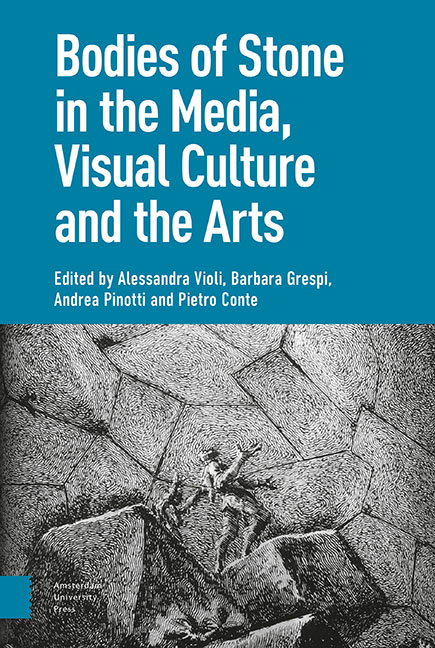Book contents
- Frontmatter
- Contents
- Introduction: Learning from Stone
- I Statue: The Imaginary of Uncertain Petrification
- 1 Theatre and Memory: The Body-as-Statue in Early Modern Culture
- 2 Translated Bodies: A ‘Cartographic’ Approach
- 3 Pantomime in Stone: Performance of the Pose and Animal Camouflage
- 4 Animated Statues and Petrified Bodies: A Journey Inside Fantasy Cinema
- 5 The Ephemeral Cathedral: Bodies of Stone and Configurations of Film
- II Matter: Size, Hardness, Duration
- 1 Bodies That Matter: Miniaturisation and the Origin(s) of ‘Art’
- 2 Brancusi’s ‘Sculpture for the Blind’
- 3 Cinema, Phenomenology and Hyperrealism
- 4 Ephemeral Bodies: The ‘Candles’ of Urs Fischer
- 5 The Celluloid and the Death Mask: Bazin’s and Eisenstein’s Image Anthropology
- III Corpse: Fossils, Auto-Icons, Revenants
- 1 Funeral Eulogy: Post-Mortem Figures and Redeemed Bodies, in Images
- 2 On Jack Torrance As a Fossil Form
- 3 Technical Images and the Transformation of Matter in Eighteenth-Century Tuscany
- 4 Glass, Mixed Media, Stone: The Bodily Stuffs of Suspended Animation
- 5 Bodies’ Strange Stories: Les Revenants and The Leftovers
- IV Monument: Embodying and Grafting
- 1 The Impassibly Fleshly, the Statue of the Impossible
- 2 Frozen into Allegory: Cleopatra’s Cultural Survival
- 3 The Orphan Image
- 4 The Well-Tempered Memorial: Abstraction, Anthropomorphism, Embodiment
- 5 Monuments of the Heart: Living Tombs and Organic Memories in Contemporary Culture
- Index
1 - Theatre and Memory: The Body-as-Statue in Early Modern Culture
Published online by Cambridge University Press: 20 November 2020
- Frontmatter
- Contents
- Introduction: Learning from Stone
- I Statue: The Imaginary of Uncertain Petrification
- 1 Theatre and Memory: The Body-as-Statue in Early Modern Culture
- 2 Translated Bodies: A ‘Cartographic’ Approach
- 3 Pantomime in Stone: Performance of the Pose and Animal Camouflage
- 4 Animated Statues and Petrified Bodies: A Journey Inside Fantasy Cinema
- 5 The Ephemeral Cathedral: Bodies of Stone and Configurations of Film
- II Matter: Size, Hardness, Duration
- 1 Bodies That Matter: Miniaturisation and the Origin(s) of ‘Art’
- 2 Brancusi’s ‘Sculpture for the Blind’
- 3 Cinema, Phenomenology and Hyperrealism
- 4 Ephemeral Bodies: The ‘Candles’ of Urs Fischer
- 5 The Celluloid and the Death Mask: Bazin’s and Eisenstein’s Image Anthropology
- III Corpse: Fossils, Auto-Icons, Revenants
- 1 Funeral Eulogy: Post-Mortem Figures and Redeemed Bodies, in Images
- 2 On Jack Torrance As a Fossil Form
- 3 Technical Images and the Transformation of Matter in Eighteenth-Century Tuscany
- 4 Glass, Mixed Media, Stone: The Bodily Stuffs of Suspended Animation
- 5 Bodies’ Strange Stories: Les Revenants and The Leftovers
- IV Monument: Embodying and Grafting
- 1 The Impassibly Fleshly, the Statue of the Impossible
- 2 Frozen into Allegory: Cleopatra’s Cultural Survival
- 3 The Orphan Image
- 4 The Well-Tempered Memorial: Abstraction, Anthropomorphism, Embodiment
- 5 Monuments of the Heart: Living Tombs and Organic Memories in Contemporary Culture
- Index
Summary
Abstract
This chapter relates the statue-like bodies of some Elizabethan and early Jacobean plays to the theories about memory and forgetting that were circulating in late sixteenth-century philosophical and medical discourse. In particular, the chapter shows how memory images, which in antiquity played a pivotal role in the art of memory, were represented as inducing a paralysing, statue-like state in living bodies. Shakespeare's work partakes in this re-assessment of memory images, as words are more powerful memory triggers and carriers than monuments and statues. Moreover, while Shakespeare's tragedies stage bodies turning into stone because of the destructive fixedness of the past, his late plays manage to set in motion the images produced by memory and by so doing resist death-like paralysis.
Keywords: Cultural representation of memory; memory images; lethargy; pathological memory; statue-like bodies
Cuncta fluunt, omnisque vagans formatur imago.
‒ Ovid, MetamorphosesXV, 178My exploration of the cultural significance of ‘bodies of stone’ will be focused on the threshold of modernity, and in particular on the early modern stage. During that age, dominated by important epistemological changes, spectators would quite frequently find plays staging characters whose bodies temporarily or permanently experienced some kind of statue-like state. Frozen in death, real or apparent, fixed in the present moment or simply unable to move or take action, these characters certainly offer a spectacular unsettling of the boundaries separating the animate from the inanimate and the human from the non-human. In this chapter I would like to relate the stone-like bodies that may be found in a number of Elizabethan and early Jacobean plays to some theories about memory and forgetting that were circulating in late sixteenth-century philosophical and medical discourses. In particular, I shall attempt to explore the contrast between the immovable and the moving statue-like body from the perspective of the different attitude towards memory that these bodies entail.
Statues of memory
Early modern culture inherits from the Middle Ages a fascination with the power of visual exemplato assist the processes of remembrance. As scholars such as Frances A. Yates, Lina Bolzoni and Pietro Corsi have amply demonstrated, the so-called art of memory was a system of mnemonic techniques that, dating back to the Classical age, bloomed in the Renaissance thanks to its eminently visual power.
- Type
- Chapter
- Information
- Publisher: Amsterdam University PressPrint publication year: 2020

